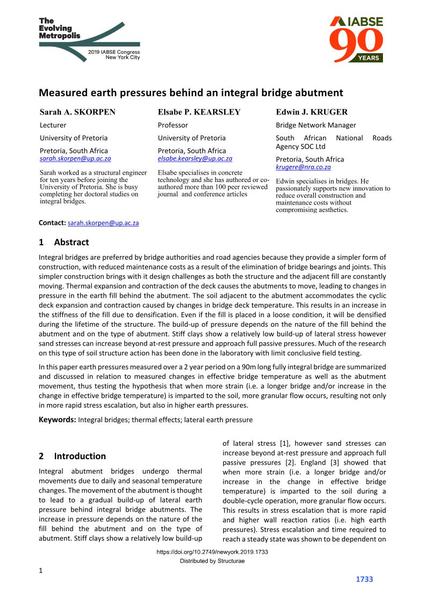Measured earth pressures behind an integral bridge abutment

|
|
|||||||||||
Détails bibliographiques
| Auteur(s): |
Sarah A. Skorpen
(University of Pretoria)
Elsabe P. Kearsley (University of Pretoria) Edwin J. Kruger (South African National Roads Agency SOC Ltd) |
||||
|---|---|---|---|---|---|
| Médium: | papier de conférence | ||||
| Langue(s): | anglais | ||||
| Conférence: | IABSE Congress: The Evolving Metropolis, New York, NY, USA, 4-6 September 2019 | ||||
| Publié dans: | The Evolving Metropolis | ||||
|
|||||
| Page(s): | 1733-1740 | ||||
| Nombre total de pages (du PDF): | 8 | ||||
| DOI: | 10.2749/newyork.2019.1733 | ||||
| Abstrait: |
Integral bridges are preferred by bridge authorities and road agencies because they provide a simpler form of construction, with reduced maintenance costs as a result of the elimination of bridge bearings and joints. This simpler construction brings with it design challenges as both the structure and the adjacent fill are constantly moving. Thermal expansion and contraction of the deck causes the abutments to move, leading to changes in pressure in the earth fill behind the abutment. The soil adjacent to the abutment accommodates the cyclic deck expansion and contraction caused by changes in bridge deck temperature. This results in an increase in the stiffness of the fill due to densification. Even if the fill is placed in a loose condition, it will be densified during the lifetime of the structure. The build‐up of pressure depends on the nature of the fill behind the abutment and on the type of abutment. Stiff clays show a relatively low build‐up of lateral stress however sand stresses can increase beyond at‐rest pressure and approach full passive pressures. Much of the research on this type of soil structure action has been done in the laboratory with limit conclusive field testing. In this paper earth pressures measured over a 2 year period on a 90m long fully integral bridge are summarized and discussed in relation to measured changes in effective bridge temperature as well as the abutment movement, thus testing the hypothesis that when more strain (i.e. a longer bridge and/or increase in the change in effective bridge temperature) is imparted to the soil, more granular flow occurs, resulting not only in more rapid stress escalation, but also in higher earth pressures. |
||||
